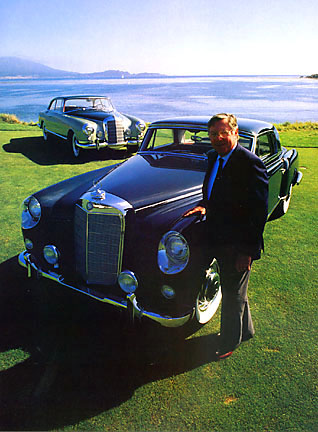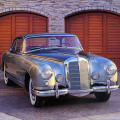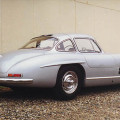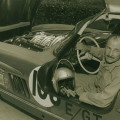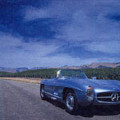The first of two Pinin Farina concept cars, known affectionately as the Italian Mercedes-Benz, built in 1955 and 1956 on the 300-series chassis was featured in our January/February issue. The body design of that 300b-based 1955 Coupe was far more complicated than this second version, completed a year later; while the bodybuilder’s approach to both cars was very similar, the resulting designs are quite different.
Carrozzeria Pininfarina, established in 1930, has executed only four designs on post-war Mercedes-Benz chassis. The first was the 1955 300b Coupe; this Coupe is the second. (The third, a 1965 230SL, was featured in our November/December 1988 issue. The so-far-undiscovered fourth is a purposeful-looking 300SEL 6.3 Coupe.) In August vve had the opportunity to photograph both Coupes together at the Pebble Beach concours d’elegance—with Sergio Pininfarina on hand to describe these two significant Italian-bodied Mercedes-Benz models.
Signore Pininfarina, who succeeded his father as head of the international design firm in 1966, worked on both the 300b and 300Sc. When they were penned, Batista “Pinin” Farina still headed the Turin design firm. (The family surname was Farina; “Pinin” was the father’s nickname. The business was Pinin Farina until 1961, when both family and company names were legally changed to Pininfarina.)
“My father was thc boss!” says Sergio, gesturing with a broad swing of his right hand to the sky. “He was responsible for every design. However, you must understand, no one person designed a car at Pininfarina. They were created by teams which brought ideas to my father for approval. Yes, in the end he was responsible for every detail; we had to get his final say on everything.”
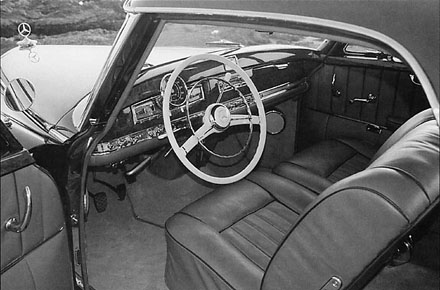
Production Relatives
Looking at the 1955 and 1956 Pinin Farina Coupes, you might think that their coachwork predicted that of the 1956-59 220S and 1959-60 220SE Coupes. Some similarities are undeniable, but given the time required to design and produce a new car, the 220s were undoubtedly on the drawing board well before the Italian cars ever existed.
Farina’s interpretation of the sporty, two-door couples was distinctively different in appearance from Mercedes-Benz 300Sc designs available in 1955, and you have to wonder where his inspiration for this design came from.
“Always my father and myself had great respect for the Mercedes-Benz tradition and for the Mercedes-Benz presige.” Sergio stops to make his point very clear. “This was one of the rare occasions when you design an automobile to express your feelings. To pay a compliment. Mercedes-Benz was one of the most famous, most noticed European firms, so you can understand how important it was for us to make a special design on this famous chassis.”
When Mercedes-Benz designers saw the first car in 1955, Sergio says, the felt complimented. “They were happy to see our contribution.”

Contrasts
Interestingly, of the two cars, the first is Sergio’s favorite. “The headlights on the first coupe were more finely integrated than they were on the 195 model. The second car was also much smaller [built on a 2,900-mm chassis]. The Sc demanded a shorter roofline and a different type of backlight [rear window] treatment. It did not have the long, flowing lines of the 1955.”
The two cars indeed form a contrast with one another. In many respects the Sc is far more graceful on the shorter wheelbase than the 300b appears on the long 3,050-mm chassis. The Sc is also more in line with the styling of the 1957 220S Coupe, which has a similar roofline, rear window, and rear fender design. The Pinin Farina treatment in these areas, however, is arguably more elaborate in its use of curves and chrome accents. Its elegantly notched rear pillar shape was carried on for the 1960s 220, 250, and 280 coupes.
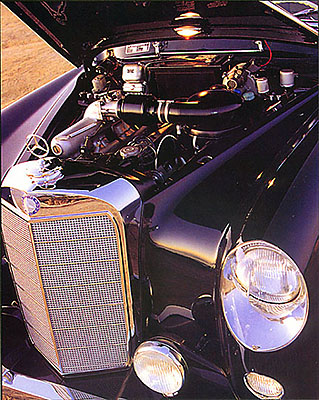
As to which of the two 300 coupes is the more attractive, that is purely a matter of personal taste. The 300Sc’s grille is decidedly more imposing than the 300b’s narrower sedan-style grille. Based on what was behind those grilles, performance is simpler to delineate. Although their inline six-cylinder, three-liter engines are similar, the lighter, fuel-injected, 175-hp 300Sc is much more energetic than the carbuerated 300b, which makes 50 hp less.
Feature Car
After being displayed at the Turin auto show, this 300Sc was ultimately bought by a collector in Switzerland, who kept it until 1989. The coupe was purchased that year by American collector Thomas Taffet, who had the car shipped to Seattle. Staff from Scott Restorations took delivery there and drove it 1,200 miles to Van Nuys, California to begin their year-long restoration. Fred Kriz, Los Angeles Section, who owns the 1955 300b Coupe, purchased the Sc version while it was at Scott’s, giving him a unique pair of one-off Pinin Farina coupes.
